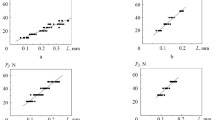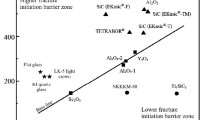Abstract
Fracture toughness is an important index in safety evaluation for materials and structures. Its convenient and accurate characterization has attracted extensive attention. For small specimens, traditional testing methods of fracture toughness are not suitable due to limitations in sample size and shape. In this work, a new formula is proposed to determine the fracture toughness of glasses using scratch tests with a Vickers indenter based on dimensional analysis and finite element analysis. Fracture toughness of glasses could be calculated with elastic modulus, crack depth of scratched materials and normal force applied during the scratch tests. The effects of plastic deformation and interfacial friction between the Vickers indenter and scratched materials are considered, and the crack shape is consistent with experimental observations. The proposed formula is verified by comparing the fracture toughness of soda-lime and borosilicate glasses obtained from scratch tests with those obtained via indentation tests. This work provides an alternative method to determine the fracture toughness of glass materials.








Similar content being viewed by others
References
Cook R, Pharr G. Direct observation and analysis of indentation cracking in glasses and ceramics. J Am Ceram Soc. 1990;4:787–817. https://doi.org/10.1111/j.1151-2916.1990.tb05119.x.
Anderson TL. Fracture mechanics: fundamentals and applications. Bona Raton: CRC Press; 2001.
Bao C, Cai L, Shi K, et al. Improved normalization method for ductile fracture toughness determination based on dimensionless load separation principle. Acta Mech Solida Sin. 2015;25(2):168–81. https://doi.org/10.1016/S0894-9166(15)30005-7.
Hong SH, Kim HY, Lee JR. Crack propagation behaviour during three-point bending of polymer matrix composite/Al2O3/polymer matrix composite laminated composites. Mat Sci Eng A - Struct. 1995;194:157–63. https://doi.org/10.1016/0921-5093(94)09677-5.
To T, Célarié F, Roux-Langlois C, et al. Fracture toughness, fracture energy and slow crack growth of glass as investigated by the Single-Edge Precracked Beam (SEPB) and Chevron-Notched Beam (CNB) methods. Acta Mater. 2018;146:1–11. https://doi.org/10.1016/j.actamat.2017.11.056.
Bao C, Cai LX. Investigation on compliance rotation correction for compact tensile specimen in unloading compliance method. Acta Mech Solida Sin. 2011;24(2):144–52. https://doi.org/10.1016/S0894-9166(11)60016-5.
Lawn B, Wilshaw R. Indentation fracture: principles and applications. J Mat Sci. 1975;10:1049–81.
Malzbender J, den Toonder JMJ, Balkenende AR, et al. Measuring mechanical properties of coatings: a methodology applied to nano-particle-filled sol-gel coatings on glass. Mat Sci Eng R. 2002;36:47–103.
Zhao MH, Yang F, Zhang TY. Delamination buckling in the microwedge indentation of a thin film on an elastically deformable substrate. Mech Mater. 2007;39:881–92. https://doi.org/10.1016/j.mechmat.2007.03.003.
Quinn GD, Bradt RC. On the Vickers indentation fracture toughness test. J Am Ceram Soc. 2007;90:673–80. https://doi.org/10.1111/j.1551-2916.2006.01482.x.
Rickhey F, Marimuthu KP, Lee JH, et al. Evaluation of the fracture toughness of brittle hardening materials by Vickers indentation. Eng Fract Mech. 2015;148:134–44. https://doi.org/10.1016/j.engfracmech.2015.09.028.
Ma DJ, Sun L, Wang LZ, et al. A new formula for evaluating indentation toughness in ceramics. Exp Mech. 2018;58:177–82. https://doi.org/10.1007/s11340-017-0325-8.
Evans AG, Charles EA. Fracture toughness determinations by indentation. J Am Ceram Soc. 1976;59:371–2. https://doi.org/10.1111/j.1151-2916.1976.tb10991.x.
Lawn BR, Evans AG, Marshall DB. Elastic/plastic indentation damage in ceramics: the median/radial crack system. J Am Ceram Soc. 1980;63:574–81. https://doi.org/10.1111/j.1151-2916.1980.tb10768.x.
Feng Y, Zhang T, Yang R. A work approach to determine Vickers indentation fracture toughness. J Am Ceram Soc. 2011;94:332–5. https://doi.org/10.1111/j.1551-2916.2010.04289.x.
Feng Y, Zhang T. Determination of fracture toughness of brittle materials by indentation. Acta Mech Solida Sin. 2015;28(3):221–34. https://doi.org/10.1016/S0894-9166(15)30010-0.
Ostojic P, Mcpherson R. A review of indentation fracture theory: its development, principles and limitations. Int J Fract. 1987;33(4):297–312. https://doi.org/10.1007/BF00044418.
Jiang H, Browning R, Sue HJ. Understanding of scratch-induced damage mechanisms in polymers. Polymer. 2009;50:4056–65. https://doi.org/10.1016/j.polymer.2009.06.061.
Jiang H, Zhang J, Yang Z, et al. Modeling of competition between shear yielding and crazing in amorphous polymers’ scratch. Int J Solids Struct. 2017;124:215–28. https://doi.org/10.1016/j.ijsolstr.2017.06.033.
Zhang J, Jiang H, Jiang C, et al. Experimental and numerical investigations of evaluation criteria and material parameters’ coupling effect on polypropylene scratch. Polym Eng Sci. 2018;58:118–22. https://doi.org/10.1002/pen.24538.
Bull SJ, Berasetegui EG. An overview of the potential of quantitative coating adhesion measurement by scratch testing. Tribol Int. 2006;39:99–114. https://doi.org/10.1016/j.triboint.2005.04.013.
Holmberg K, Laukkanen A, Ronkainen H, et al. A model for stresses, crack generation and fracture toughness calculation in scratched TiN-coated steel surfaces. Wear. 2003;254:278–91. https://doi.org/10.1016/S0043-1648(02)00297-1.
Blackman BRK, Hoult T, Patel Y, et al. Steady-state scratch testing of polymers. Polym Test. 2016;49:38–45. https://doi.org/10.1016/j.polymertesting.2015.11.002.
Wakeel SA, Hubler MH. Introducing heterogeneity into the micro-scratch test fracture toughness relation for brittle particle composites. Exp Mech. 2018;58:1237–47. https://doi.org/10.1007/s11340-018-0408-1.
Subhash G, Loukus JE, Pandit SM. Application of data dependent systems approach for evaluation of fracture modes during a single-grit scratching. Mech Mater. 2002;34:25–42. https://doi.org/10.1016/S0167-6636(01)00083-7.
Cook RF. Fracture mechanics of sharp scratch strength of polycrystalline alumina. J Am Ceram Soc. 2017;100:1146–60. https://doi.org/10.1111/jace.14634.
Liu HT, Zhao MH, Zhang JW. Fracture properties of surface modification layers via a modified bi-layer beam model. J Mech. 2019;35:499–511. https://doi.org/10.1017/jmech.2018.36.
Akono A, Reis PM, Ulm F. Scratching as a fracture process: from butter to steel. Phys Rev Lett. 2011;106:20430220. https://doi.org/10.1103/PhysRevLett.106.204302.
Akono A, Ulm F. Scratch test model for the determination of fracture toughness. Eng Fract Mech. 2011;78:334–42. https://doi.org/10.1016/j.engfracmech.2010.09.017.
Lin J, Zhou Y. Can scratch tests give fracture toughness? Eng Fract Mech. 2013;109:161–8. https://doi.org/10.1016/j.engfracmech.2013.06.002.
Liu M, Yang S, Gao C. Scratch behavior of polycarbonate by Rockwell C diamond indenter under progressive loading. Polym Test. 2020;90:106643. https://doi.org/10.1016/j.polymertesting.2020.106643.
Zhang D, Sun Y, Gao C, Liu M. Measurement of fracture toughness of copper via constant-load microscratch with a spherical indenter. Wear. 2020;444–445:203158. https://doi.org/10.1016/j.wear.2019.203158.
Liu HT, Zhao MH, Lu CS, et al. Characterization on the yield stress and interfacial coefficient of friction of glasses from scratch tests. Ceram Int. 2020;46:6060–6. https://doi.org/10.1016/j.ceramint.2019.11.065.
Wang W, Yao P, Wang J, et al. Elastic stress field model and micro-crack evolution for isotropic brittle materials during single grit scratching. Ceram Int. 2017;43:10726–36. https://doi.org/10.1016/j.ceramint.2017.05.054.
Sani G, Limbach R, Dellith J, et al. Surface damage resistance and yielding of chemically strengthened silicate glasses: from normal indentation to scratch loading. J Am Ceram Soc. 2021. https://doi.org/10.1111/jace.17758.
Matsuoka J, Guo D, Yoshida S. Cross-section morphology of the scratch-induced cracks in Soda-lime-silica glass. Front Mater. 2017;4:8. https://doi.org/10.3389/fmats.2017.00008.
Shah RC, Kobayashi AS. Effect of poisson’s ratio on stress intensity magnification factor. Int J Fract. 1973;9:360–1. https://doi.org/10.1007/BF00049223.
Konda N, Erdogan F. The mixed mode crack problem in a nonhomogeneous elastic medium. Eng Fract Mech. 1994;47:533–45. https://doi.org/10.1016/0013-7944(94)90253-4.
Lacroix R, Kermouche G, Teisseire J, et al. Plastic deformation and residual stresses in amorphous silica pillars under uniaxial loading. Acta Mater. 2012;60:5555–66. https://doi.org/10.1016/j.actamat.2012.07.016.
Lin JS, Zhou Y. Rebuttal: shallow wide groove scratch tests do not give fracture toughness. Eng Fract Mech. 2015;133:211–22. https://doi.org/10.1016/j.engfracmech.2014.10.030.
Anstis GR, Chantikul P, Lawn BR, et al. A critical evaluation of indentation techniques for measuring fracture toughness: I, direct crack measurements. J Am Ceram Soc. 1981;64:533–8.
Iwata K, Tonegawa A, Nishi Y. Reduce brittleness of borosilicate glass by electron beam irradiation. J Jpn I Met. 2005;69:380–4. https://doi.org/10.2320/jinstmet.69.380.
Gong J, Chen Y, Li C. Statistical analysis of fracture toughness of soda-lime glass determined by indentation. J Non-Cryst Solids. 2001;279:219–23. https://doi.org/10.1016/S0022-3093(00)00418-X.
Mueller MG, Pejchal V, Zagar G, et al. Fracture toughness testing of nanocrystalline alumina and fused quartz using chevron-notched microbeams. Acta Mater. 2015;85:385–95. https://doi.org/10.1016/j.actamat.2014.12.016.
Acknowledgements
The authors thank the financial support from National Natural Science Foundation of China (Nos. 12072324 and U1804254) and Natural Science Foundation of Henan Province for Excellent Young Scholars (212300410087).
Author information
Authors and Affiliations
Corresponding authors
Rights and permissions
Springer Nature or its licensor holds exclusive rights to this article under a publishing agreement with the author(s) or other rightsholder(s); author self-archiving of the accepted manuscript version of this article is solely governed by the terms of such publishing agreement and applicable law.
About this article
Cite this article
Liu, H., Zhang, J., Zhao, M. et al. Determination of the Fracture Toughness of Glasses via Scratch Tests with a Vickers Indenter. Acta Mech. Solida Sin. 35, 129–138 (2022). https://doi.org/10.1007/s10338-021-00264-6
Received:
Revised:
Accepted:
Published:
Issue Date:
DOI: https://doi.org/10.1007/s10338-021-00264-6




